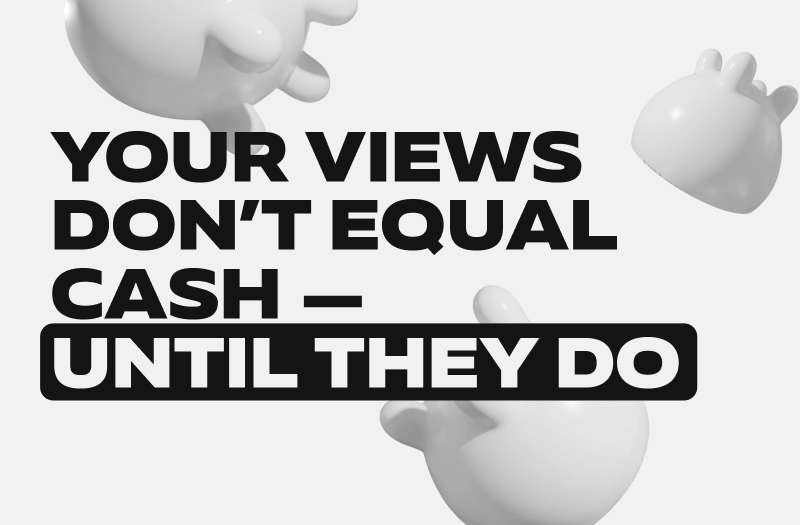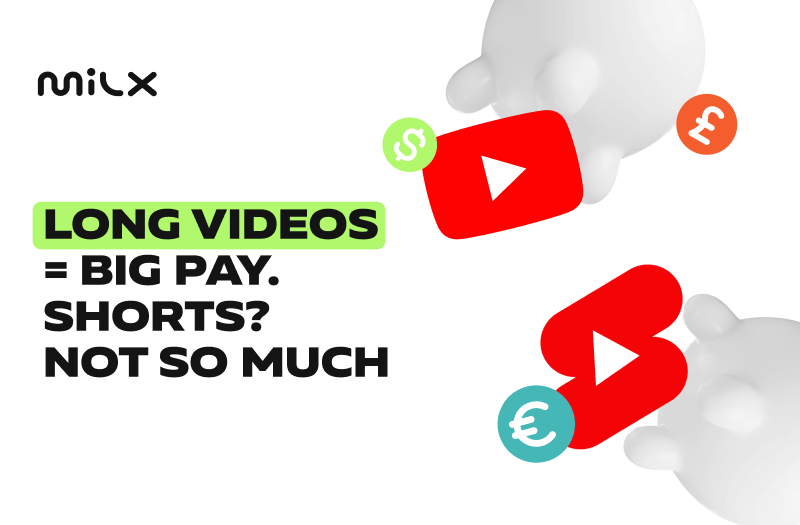How much cash does 1 million views on YouTube actually bring in? The answer isn’t as simple as one number. From ad formats and audience location to the type of content you create, a lot goes into what YouTube pays.
In this blog, we’re breaking down the numbers behind YouTube payouts, what actually influences your earnings, and how you can make the most of every view. Plus, we’ll show you how MilX can help you with faster payouts, higher earning potential, and powerful financial tools designed to help creators grow.
What is the Average Pay for 1 million of YouTube Views
Many creators are surprised when they find out how much money does YouTube pay for 1 million views, it's not always as high as you'd expect.
If you’re thinking “a small fortune,” not quite, but it’s not bad either. So what does YouTube pay for 1 million views? According to Influencer Marketing Hub YouTubers earn anywhere from $1,000 to $5,000 (or even up to $18,000 per million views) just from ads (thanks, AdSense!).
But here's the fun part, that number’s all over the place. Depending on your niche, audience, and a bit of algorithm luck, it could be way less… or a whole lot more. YouTube doesn’t pay you just for views, it pays when people watch or click ads on your videos.
No ad views = no revenue. MilX users saw a huge boost in earnings just by adjusting ad break placements, timing really is everything.
In addition, with the YouTube Partner Program (YPP), you can also unlock other income streams like memberships, Super Chats, Super Stickers, Super Thanks, and YouTube Premium Revenue. Your total earnings depend on how well you use these tools, and how your audience responds.
If you’re already making money — don’t wait to use it.
MilX lets you access your YouTube income daily, or even upfront. Download the free app on iOS or Android and check how much extra cash you can request today.
Key Factors of YouTube Advertising Revenue Rates
You hit “publish,” the views roll in, but the revenue? That’s a whole different story. Your YouTube payment per view depends on factors like ad type, viewer location, and your channel’s engagement rate. Let’s break down the key factors that decide whether you earn pennies or serious cash per 1,000 views.
Ad Formats of Choice
There are different types of ad format on YouTube that can seriously impact how much you earn.
Skippable In-stream Ads
The classic "skip in 5 seconds" ad. Viewers love to skip, but if they hang around, or click, you still get paid. It’s the bread-and-butter format for most creators, offering solid, steady income.
Non-skippable In-stream Ads
These 15–20 second ads force viewers to watch the whole thing, and brands pay extra for that kind of attention. That means more cash in your pocket, but you should remember about the viewer experience and test this format carefully.
Bumper Ads
Tiny but mighty. These 6-second, non-skippable ads flash by before viewers can blink. They don’t rake in tons, but they’re quick, painless, and add up over time.
Display Ads
These desktop-only ads chill beside your video without getting in the way. They're low-key money-makers, but they stack up quietly in the background.
Overlay Ads
These semi-transparent pop-ups slide across the bottom of your video. Not the flashiest, and not the biggest earners, but they do their part, especially for desktop viewers.
YouTube Shorts Ads
Shorts are YouTube’s answer to TikTok, and they've been monetized for some time now. Ads sneak in between videos, and while the payout’s started to grow during the last months, it still can’t compare to the cash long videos make.

Actual CPM Rates
CPM (Cost per 1,000 views) is where the money talk gets real. It’s the number advertisers are willing to pay for every thousand views on your videos, and it’s one of the biggest factors shaping your YouTube income.
On average, CPM rates sit anywhere between $1 to $20, but most creators fall into the $3–$5 range. However, if you’re in a high-paying niche like finance, tech, or business, CPMs can skyrocket to $15 or more. Meanwhile, creators in lifestyle, gaming, or entertainment might see lower rates.
One thing you need to understand is that CPM isn’t a fixed number. It’s highly dynamic and changes constantly based on factors like your channel’s niche, where your viewers are located, the time of year, and even the ad formats being served. For example, CPMs can spike in December thanks to holiday ad budgets, then drop significantly in January when the new year starts.
And while we’re on the topic, it’s also worth mentioning RPM (revenue per thousand views), another key metric you should be tracking.
Here’s the difference:
- CPM is what advertisers pay YouTube for 1,000 ad impressions.
- RPM is what you actually earn per 1,000 total views, including income from ads, YouTube Premium, Super Chats, and more.
So CPM shows the potential, while RPM shows the reality.
Geography of Channel Registrations and Viewers
When it comes to making money on YouTube, location is everything, and not just yours, but your audience’s too. Advertisers pay more to target viewers in high-income countries like the U.S., Canada, UK, Australia, and Germany. That’s why creators with large audiences in these regions often enjoy higher CPMs, sometimes $10+ per 1,000 views.
On the flip side, if most of your viewers are in countries with lower ad spending (think India, Philippines, or many parts of Africa and South America), your CPM could drop to $1 or less. Same number of views, but way less cash.
If you're going global, target wisely. Where your views come from can make or break your earnings.
Growing your channel takes money. MilX helps you find it.
Unlock up to six months of your future YouTube income and use it now — for new gear, hiring help, or finally launching that big project.
Demographics of Your Audience
It’s not just how many people watch your videos, it’s who they are that really counts. Age, gender, income level, and interests all shape how much advertisers are willing to spend to reach your audience.
For example, if your viewers are mostly 25–44-year-olds, congrats, you’re in the advertiser sweet spot. That age group tends to have more buying power, which means higher CPMs. Similarly, an audience made up of business owners, parents, or tech enthusiasts is gold for advertisers, so they’ll pay more to get in front of them.
On the other hand, a channel with mostly teen or kid viewers might pull in fewer ad dollars (unless it's paired with toy or gaming sponsors), since that group doesn’t have as much spending power.
Advertisers don’t just want views, they want the right viewers. And the closer your audience aligns with their target market, the more you earn per view.
Getting YouTube pay for a million views feels rewarding, but the exact number depends heavily on how you monetize your content.

Channel’s Niche and Content Topics
Your content niche is one of the biggest money-makers (or deal-breakers) on YouTube because some topics attract higher-paying ads than others. For example, channels that focus on finance, investing, tech, software, and business often land premium CPMs, sometimes $10 to $20+ per 1,000 views. That’s because advertisers in these spaces have big budgets and high-value products to promote.
Meanwhile, fun and casual niches like vlogs, pranks, gaming, or beauty might pull in way more views, but the CPMs are usually lower, often $1 to $7, since the ads are more general and less targeted.
So while going viral is great, being in a high-paying niche can earn you more with fewer views.
Accordion to Uscreen.tv Top-Paying YouTube Niches (By Average CPM):
- Make money online: $13.52;
- Finance & investing: $12.25;
- Educational videos: $9.89;
- Photography & filmmaking: $7.31;
- Cars (automotive): $4.23;
- Lifestyle: $3.47;
- Fashion & clothing: $3.13;
- Entertainment: $2.74;
- Cooking: $2.50;
Still note that these figures are approximate and can vary based on factors such as audience demographics, engagement rates, and content quality.
YouTube Video vs. YouTube Shorts: How Much Does YouTube Pay for 1 Million Views
When it comes to getting paid for 1 million views on YouTube, the difference between regular videos and Shorts is pretty huge. The YouTube pay for 1 million views could be as low as $50 for Shorts or as high as $10,000+ for long-form videos in profitable niches.
For traditional long-form YouTube videos (typically over 8 minutes), creators usually earn between $1,000 and $5,000 per 1 million views through AdSense. That number can go much higher, up to $10,000 or more, if the channel covers high-paying niches like finance, tech, or business. On top of that, creators can boost their revenue even further with sponsorships, affiliate marketing, and merch sales.
In contrast, YouTube Shorts generate significantly less revenue. Since YouTube introduced ad revenue sharing for Shorts in 2023, creators now get a cut of ads shown between videos in the Shorts feed. But the payouts are much lower, roughly $50 to $100 per 1 million views, with some top-performing Shorts creators reportedly making up to $200–$300 per million views in rare cases.CPM on Shorts has been climbing across all regions over the past year. It’s still not on par with long-form videos, but the upward trend is definitely there. While Shorts can help grow your audience quickly and open up other income streams (like brand deals), they’re not the go-to format if you’re relying on ad revenue alone.
If you want to earn real money from views, long-form videos still pay off best. Shorts are great for reach, but not so much for revenue, at least for now.
- Jenny Hoyos accumulated over 22 million views on her Shorts and earned $1,200 in ad revenue, translating to about $54.55 per 1 million views.
- Meanwhile, Mighty Networks reports that the average earnings for 1 million views on standard YouTube videos are approximately $2,950, based on an average rate of $2.95 per 1,000 views.
Anyway, your YouTube income per views may not seem impressive at first, but it adds up quickly with the right strategy and audience.

What MilX Does for Creators Like You
You can earn a lot from a million views. Or very little. Either way, there are tools that can solve a lot of the financial problems creators face on YouTube.
The free MilX app helps you get your money faster, with more flexibility — and gives you a way to use your future income now, without waiting for YouTube’s calendar to catch up.
Here’s what creators use MilX for:
- To get paid daily, instead of once a month.
- To unlock future earnings when they want to move faster.
- To get paid in USD, EUR, or crypto — whatever works.
- To have the lowest money transfer fees on the market.
- To send money to their team instantly, with no fees.
If you’ve ever looked at your analytics and thought, “Why can’t I use this money now?” — MilX fixes that.
Download MilX on the App Store or Google Play and take control with 10+ payment methods and access to extra funds when you need them.

